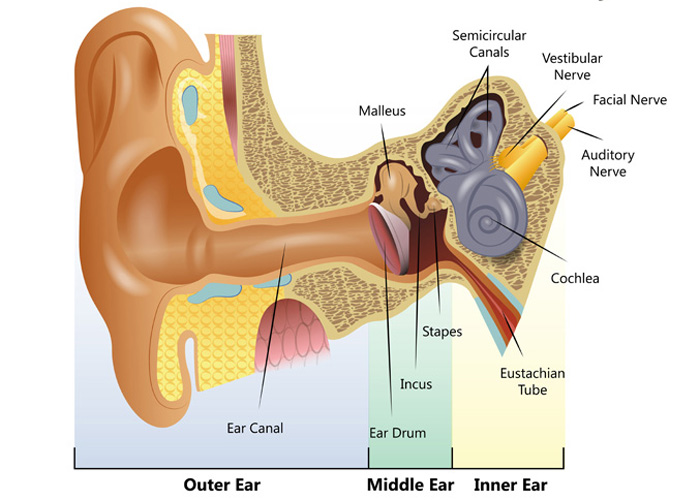What Separates the Outer Ear From the Middle Ear
The tympanic membrane is also called the eardrum. Sound travels through the auricle and the auditory canal a short tube that ends at the eardrum.

The Hearing System The Hearing Center Dallas And Frisco Texas
View the full answer.

. Outer ear consists of pinna. The external ear has two parts the auricle and the pinna. The tympanic Membranes main function is to assist in human hearing.
The tympanic membrane is at the end of the auditory canalTF. The middle ear is separated from the external ear by the tympanic membrane the eardrum and from the inner ear by a lateral wall that contains the round and oval windows. It consists of three parts outer ear middle ear and inner ear.
The vibrations are then transferred to the tiny bones in the middle ear. The ossicles are in the middle ear. The eardrum is the tympanic membrane and it is responsible for receiving sound vibrations present in the outside air and transmitting them to the middle ear or auditory ossicle.
A structure that separates the outer ear from the middle ear and vibrates in response to sound waves. View the full answer. Despite the diminutive size.
The membrane vibrates with the force of a sound wave strike and transmits the vibrations further into the bones of the middle ear. The external auditory canal is __-shaped in the adult. Sound entering the outer ear travels through the middle ear and causes the eardrum and ossicles in the middle ear to vibrate.
Asked Aug 18 2019 in Psychology by lovelynyrican. The eardrum is a tympanic membrane separates the outer and middle ear. The auditory system is divided into three parts the outer ear the middle and the inner ear.
The middle ear is also called the tympanic cavity or tympanum. Middle ear the chamber between the eardrum and cochlea containing three tiny bones hammer anvil and stirrup that concentrate the vibrations of the eardrum on the cochleas oval window. The malleus incus and stapes are responsible for transmitting sound waves from the eardrum to the inner ear through the ___ window.
What separates the outer ear from the middle ear. What structure separates the outer from middle ear. It acts to separate the outer ear from the middle ear.
Therefore the correct answer is option A. The middle ear is also known as the tympanic cavity. In the context of the structure of the ear which of the following is also known as the tympanic membrane separates the outer ear from the middle ear and vibrates in response to sound.
Tympanic membrane is a thin semi-transparent oval shaped membrane that separates the external ear from the middle ear. The external ear middle ear and inner ear. The tympanic membrane is a very thin structure that separates the outer ear canal from the middle ear space.
The human ear is typically divided into three portions. Anatomy of the middle ear. Ear is responsible for hearing and balance.
It separates the outer ear from the middle ear. The tympanic membrane is composed of thin connective tissue membranes that remain covered by skin and mucosa. Parts of the Middle Ear The middle ear is an air-filled cavity that sits between the tympanic membrane 3 and the inner ear.
As it travels it amplifies gets louder and changes from air to liquid. Pharyngotympanic tube Connects the middle ear to the pharynx Semicircular canal Contains the ampullae involved in maintaining equilibrium during rotational acceleration of the head Tympanic membrane Separates the outer ear from t. The middle ear contains the three small bones ossicles involved in the transmission of sound and is connected to the throat at the nasopharynx via the pharyngeal opening of the Eustachian tube.
The pressure is maintained in each ear by a eustachian or pharyngotympanic tube. The outer ear is separated from the middle ear by the tympanic membrane the eardrum. The tympanic membrane or eardrum is the final hearing organ in the outer ear separating it from the middle ear.
Most hearing disabilities are caused by trauma or disorders in the tympanic membrane eardrum. The eardrum separates the outer ear from the air-filled tympanic cavity of the middle ear. It is a pressurized membrane-lined air-filled cavity separating the inner ear from the external environment.
Ear canal a tube running from the outer ear to the middle ear. The eardrum collects sound waves and vibrates passing the sound waves into the middle ear. In the context of the structure of the ear which of the following is also known as the tympanic membrane separates the outer ear from the middle ear and vibrates in response to sound.
The ___ _____ separates the external ear from the middle ear. The structure that separates the middle ear from the inner ear is the. The external ear is composed of three main parts the ear that is the outer cavity through which the sounds enter the ear canal a cavity of about 25cm through which the sounds pass until they reach the tympanum a membrane that separates the outer ear from.
Modified sweat glands in the external ear canal secrete ____. When sound waves reach the tympanic membrane they cause it to vibrate.

How We Hear Outer Middle Inner Ear Toronto Hearing Centre

Anatomy Of The Ear Audiocardio

Tympanic Membrane Definition Anatomy Function Perforation Britannica

Comments
Post a Comment